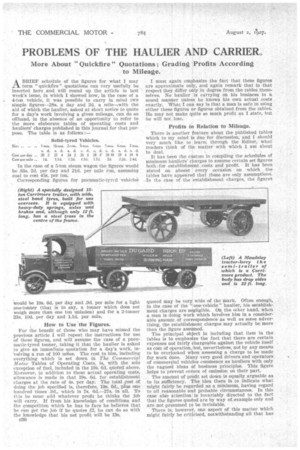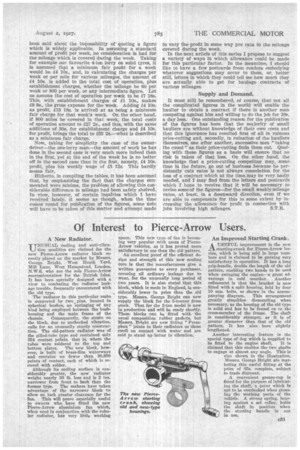PROBLEMS OF THE HAULIER AND CARRIER,
Page 52

Page 53

If you've noticed an error in this article please click here to report it so we can fix it.
More About " Quickfire " Quotations: Grading Profits According to Mileage.
A BRIEF schedule of the figures for what I may _CI term " quickfire" quotations can very usefully be inserted here and will round up the article in last week's issue, in which I showed how, in the case of a 4-ton vehicle, it was possible to carry in mind two simple figures-28s. a day and 2d. a mile=-with the aid of which the haulier, asked at short notice to quote for a day's work involving a given mileage, can do so offhand, in the -absence of an opportunity to refer to the more elaborate tables of operating -costs and hauliers' charges published in this journal for that purpose. The table is as follows:— In the case of a 5-ton steam wagon the figures would be 33s. 2d. per day and aid. per mile run, assuming coal to cost 45s. per ton.
Corresponding figures for pneumatic-tyred vehicles
would be 19s. 6d. per day and .9d. per mile for a light one-tonner (that is to say, a tonner which does not weigh more than one ton unladen) and for a 2-tonner
23s. 10d. per day and 1.1d. per mile. .
How to Use the Figures.
For the benefit of those who may have missed the previous article I will repeat the instructions for use of these figures, and will assume the case of a pneamatic-tyred tonner, taking it that the haulier is asked to give an immediate quotation for a day's work, involving a run of 3.00 miles. The cost to him, including everything which is set down in The Commercial Motor Tables of Operating Costs, is, with the sole exception of fuel, included in the 19s. 6d. quoted above. Moreover, in addition to these actual operating costs, allowance is made in that 19s. 6d. for establishment charges at the rate of 4s. per day. The total cost of doing the job specified is, therefore, 19s. 6d., plus one hundred times .9d., which is 7s. 6d.-27s. in all. To this he must add whatever profit • he thinks the job will carry. If from his knowledge of conditions and the competition which he has to face he believes that he can get the job if he quotes £2, he can do so with the knowledge that his net profit will be 13s.
e30 I must again emphasize the fact that these figures are approximate only, and again remark that in that respect they differ only in degree from the tables themselves. No haulier is carrying on his business in a sound manner unless he knows his own actual costs exactly. What I can say is that a man is safe in using either these figures or figures obtained from the tables. ' He may not make quite so much profit as I state, but he will not lose.
Profits in Relation to Mileage.
There is another feature about the published tables which to my mind is due for discussion, and I should very much like to learn; through the Editor, what readers think of the matter with which I am about to deal.
It has been the custom in compiling the schedules of minimum hauliers' charges to assume certain set figures both for establishment costs and profit. It has been stated on almost every occasion on which the tables have appeared that :these are only assumptions. In the case of the establishment charges, the figures quoted may be very wide of the mark. Often enough, in the case of the" one-vehicle" haulier, his establishment charges are negligible. On the other hand, when a man is doing work which involves him in a considerable amount of correspondence as well as some advertising, the establishment charges 1nay actually be more than the figure assumed, The principal object in including that item in the tables is to emphasize the fact that there are certain expenses not fairly chargeable against the vehicle itself as cost of operation, but, nevertheless, not by any means to be overlooked when assessing a charge to be made for work done. Many very good drivers and operators of commercial vehicles commence as hauliers with only the vaguest ideas of business principles. This figure helps to prevent errors of omission on their part.
The amount of profit set down is equally arguable as to its sufficiency. The idea there is to indicate what might fairly be regarded as a minimum, having regard to all reasonable and probable circumstances. In this case also attention is invariably directed to the fact that the figures quoted are by way of example only and are not -presumed to be inviolable.
There is, however, one aspect of this matter which might fairly be criticised, notwithstanding all that has
been said about the impossibility of quoting a figure which is widely applicable. In assuming a standard amount of profit per week, no consideration is had for the mileage which is covered during the week. Taking for example our favourite 4-ton lorry on solid tyres, it is assumed that a minimum fair profit for a week would be 14 10s., and, in calculating the charges per week or per mile for various mileages, the amount of £4 10s. is added to the total cost of operation, plus establishment charges, whether the mileage be 60 per .week or 800 per week, or any intermediate figure. Let us assume the cost of operation per week to be 17 18s. This, with establishment charges of 11 10s., makes 19 8s., the gross expense for the week. Adding /4 10s. as profit, £13 18s. is arrived at as being a minimum fair charge for that week's work. On the other hand, if 800 miles be covered in that week, the total costs of operation amount to £27 2s., and this, with the same additions of 30s. for establishment charge and 14 10s. for profit, brings the total to £33 2s.—what is described as a minimum fair charge.
Now, taking for simplicity the case of the ownerdriver—the one-lorry man—the amount of work he has done in the second case is very much more indeed than in the first, yet at the end of the week be is no better off in the second case than in the first, namely, 14 10s. profit, plus ids weekly wage of 13 12s. This hardly seems fair,
Hitherto, in compiling the tables, it has been assumed that, by emphasising the fact that the charges enumerated were minima, the problem of allowing this considerable difference in mileage had been safely shelved. In view, however, of certain inquiries which I have received lately, it seems as though, when the time comes round for publication of the figures, some note will have to be taken of this matter and attempt made
to vary the profit in some way pro rata to the mileage covered during the week.
In the next article of this series I propose to suggest a variety of ways in which allowance could be made for this particular factor. In the meantime, I should like to have a few postcards from readers embodying whatever suggestions may occur to them, or, better still, letters in which they could tell me how much they are actually able to get for haulage contracts of various mileages.
Supply and Demand.
It must still be remembered, of course, that not all the complicated figures in the world will enable the haulier to obtain a contract if there is another man competing against him and willing to do the job for 10s. a day less. One outstanding reason for the publication of the figures has been that the majority of small hauliers are without knowledge of their own costs and that this ignorance has resulted first of all in ruinous price-cutting and, secondly, in ruination of the hauliers themselves, one after another, successive men "taking the count" as their price-cutting finds them out. Quoting with these figures as a basis will ensure that no risk is taken of that loss. On the other hand, the knowledge that a price-cutting competitor may, some time in the future, go out of business because he persistently cuts rates is not always consolation for the loss of a contract which at the time may be very badly needed, and I may find from the letters and postcards which I hope to receive that it will be necessary to revise some of the figures—for the small weekly mileage rates, at least, in a downward direction, even if we are able to compensate for this to some extent by increasing the allowance for profit in connection with
jobs involving high mileages. S.T.R.












































































































